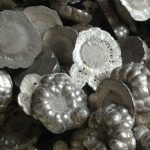Notice: Undefined index: sith_hide_share in /www/sites/alloy.wiki/index/wp-content/themes/likegoogle/single.php on line 32
Deprecated: get_settings is deprecated since version 2.1.0! Use get_option() instead. in /www/sites/alloy.wiki/index/wp-includes/functions.php on line 4862
The process deformation of titanium bar blank products is more difficult than steel to flow into the deep and narrow groove. This is because the deformation resistance of titanium is high, and the friction between things and the rough surface of the cold too fast. In order to improve the activity of the process of titanium rod blank products and improve the die life. The usual practice is to increase the die forging slope and rounded radius and the use of lubricants: the raw edge bridge on the forging die is higher than the height of the steel, usually about 2mm larger. In order to make the groove filling simply, sometimes the bridge can be used to restrict or speed up some of the metal groove. For example, a long box forging with thin front and rear side walls; The left and right side walls are thicker.

Later, the front and rear side walls were still rough groove, and the left and right side walls were changed to rough groove, because the bridge is wide in size, together with the damping ditch to prevent, make the front and rear thin side wall completely filled, and the metal is more than the use of the said rough groove method to save. When choosing the method of closed die forging to die forging the blank of titanium rod, the die life is decreased because of the high pressure. Therefore, it is necessary to strictly limit the volume of raw blank in closed die forging, which makes the preparation process messy. Whether to choose closed die forging, from the cost and technological feasibility of two aspects. When open die forging, burr loss accounts for 15% ~ 20% of the blank component, some process waste (if it is necessary to leave some according to the forging conditions) account for 10% of the blank component. The relative loss of rough metal is usually added with the reduction of the blank component. The cost of rough metal can be as high as 50% for some forgings with asymmetrical layout, large cross-sectional area difference and difficult filling. Although there is no burr loss in closed die forging, the blank production process is messy, and more transition groove needs to be added, which will undoubtedly add auxiliary costs.
One of the most useful ways to improve the preheating temperature of the die is to improve the process activity and decrease deformation resistance of the blank products of titanium rod. The isothermal die forging and hot die forging developed in the past 20 or 30 years at home and abroad provide a feasible method for the forming of the fine forgings for processing the large and disorderly rough products of titanium rods, which has been widely used in the production of titanium wire for rough products of titanium rods.
Guest contributors are welcome at the Alloy Wiki.It is a weekly wiki and guide on alloy information and processing technology, while also about the vast array of opportunities that are present in manufacturing. Our team of writers consists of a Machining Material Supplier / Machinist / Tool and Die Maker, a Biomedical Engineer / Product Development Engineer, a Job Development Coordinator / Adjunct Professor, and a President and CEO of a manufacturing facility.
Link to this article:The process deformation of titanium bar blank products
Reprint Statement: If there are no special instructions, all articles on this site are original. Please indicate the source for reprinting:Alloy Wiki,thanks!^^


